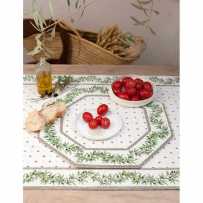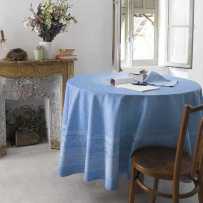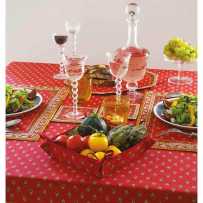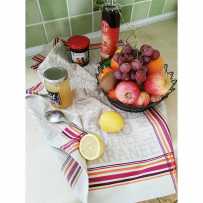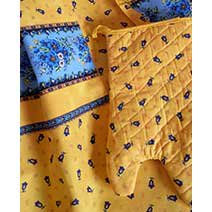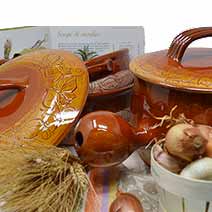It will be manufactured on order, with a (sgraffito) decoration possible on the unglazed base.
It’s perfect for healthy cooking in the oven or simmered by keeping the ingredients with juice, without drying.
Sold with instructions for use, and stamped...
Description & Product Details >>
Customize your crockery!
by indicating in your order the name or the date to be affixed to the back of the items.
For a personal quote, please Contact Us
Coordinates & accessories
Cook healthy and good
Perfect for preparing good slow-cooking dishes, this pot belly cookware contains no toxic components. The enamelled ceramic inside keeps the natural moisture of the ingredients during cooking. This "toupin" is a perfect tool for baking in the oven, meat dishes and vegetables.
The tastes and flavors of each food mingle with a subtle mellowness without risk of burning in the bottom of the pan. In addition, no need to add fat, water vapor will make it. Put more aromatics (of Provence obviously), and enjoy!
Artisanal and typical
The pottery of Vallauris is originally a traditional culinary ceramic that was born in the Gallo-Roman era thanks to clay deposits nearby. It’s now on the verge of disappearing because very few potters still make it. This skillet pan will be handmade and ordered so that you can admire every day a rare piece by its shape, and unique in its imperfection. If you like the work of a craftsman, you will love this round and jovial Provencal skillet.
Cookware
Do you like to cook family dishes, melting and juicy? Check out our provencal pottery of Vallauris: there is something for every purpose. Pan called "Parisian" in Provence, casseroles, tian, daubiere and large skillet, everything to compose pots and pans set.
Product Details
- Height
- 10 in
- Diameter
- 9 in
- Weight
- 8 lb
Manual
1 - Before first use (culinary terracotta only)
Before using your culinary pottery for the first time, we recommend to soak your pottery and its cover overnight in cold water and then to air dry thoroughly.
Then rub it with a clove of garlic and let stand for at least 5 hours.
Before use, clean it by hand, preferably with liquid Marseille soap or a diluted commercial detergent. Once dry, your terracotta pottery is ready to use.
2 - To avoid thermal shocks
Glazed terracotta and earthenware, like any ceramic, are materials sensitive to thermal shocks and can be damaged irreparably. Here are some tips to avoid breakage.
- 1st tip: Not empty!
Never heat or reheat a pottery utensil when it is empty. We recommend placing preparations or food inside, or at least a glass of water, before placing your dishes in the oven or on a cooking source.
- 2nd tip: Cold start
Whatever the heat source, you should always start your cooking in a cold oven, or on a small fire with a heat diffuser. Covered pottery retains heat and loses very little energy. You can heat up slowly. The earth gently cooks the stewed preparations, giving them back their water. These remain soft and tasty. There is no point in raising the temperature sharply. If you adhere to this principle, you can simmer unattended for a long time. Finally, do not use your pottery for quick cooking (roasting meat, for example). It is not appropriate. Prefer utensils made of iron, cast iron, etc, instead.
- 3rd tip: Do not put on a cold surface after cooking
Provide a tea towel, a cork or wooden trivet, and avoid placing it directly on a work surface. The temperature difference between very hot terracotta and a cold surface could create a shock causing cracking. Likewise, never pass from the oven to the refrigerator or vice versa. It would be fatal for your ceramic. Also, do not leave your terracotta or earthenware dish next to a cooking point. The proximity of a very hot temperature can crack the ceramic.
3 - How to clean your pottery
Even if you are using the dishwasher, you must handle your dishes avoiding any shocks. For hand cleaning, avoid metal pads and abrasive sponges. It is better to use natural detergents, such as Marseille soap products. Always rinse thoroughly, especially for utensils that have an unglazed part. You must allow your ceramic to dry completely before storing it. Place the lid separately, or staggered to prevent airtight closing while your dishes are resting. This will help prevent mold, as the terracotta retains moisture.
Thanks to these recommendations, you will rediscover the true flavor of your recipe in this natural earth, and the pleasure of sharing it at dinner.
Quality Service
REMEMBER PROVENCE
9 other products in the same category:
Questions
Je voudrais savoir si les poêlons peuvent se cuisiner sur une plaque de cuisson au gaz ?
Merci pour vos réponses.
La réponse est oui sous certaines conditions strictes : il ne faut pas de contact direct avec les flammes ou la source de chaleur. Nous recommandons d'utiliser un diffuseur qui se met en dessous du poêlon pour atténuer le contact.
Cela dit, bien qu'un poêlon s'utilise généralement pour faire frire des légumes, il vaut mieux le faire au préalable avec une poêle standard, et finir la cuisson au four dans le poêlon en terre. Cela donnera à votre préparation un goût incomparable.
Je vois dans les fiches techniques que le feu de cheminée est possible pour certains articles est ce que je peux les utiliser dans un four à pizzas sans prendre de risque ?
Rien n'est impossible à condition que la céramique soit initialement placée sur une surface froide au départ, car la montée en température doit se faire très progressivement pour éviter un choc thermique. Si vous posez votre pot en terre directement sur les briques déjà chaudes, le risque est élevé. Cela est vrai quel que soit le mode de chaleur utilisé. Il ne faut, bien sûr, aucun contact avec la flamme directe.











